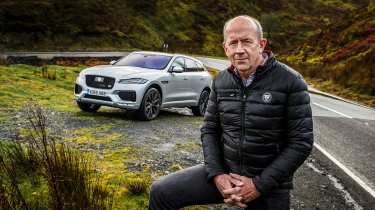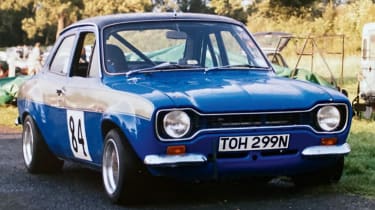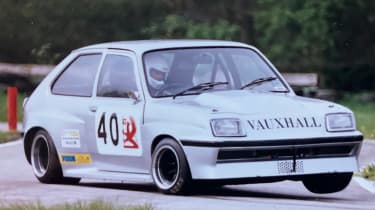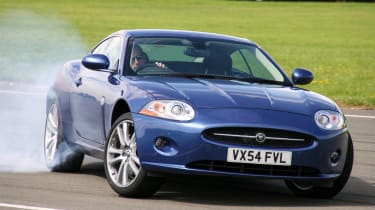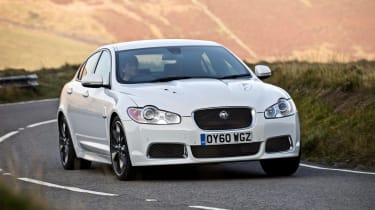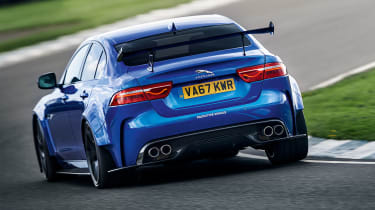My Life & Cars – Mike Cross, Vehicle dynamics engineer
After 37 years of shaping the dynamic character of Jaguars, Land Rovers and Range Rovers, Mike Cross retired as JLR’s director of Vehicle Targets and Sign-off
The 2013 Goodwood Festival of Speed offered a vignette of what Mike Cross has brought to Jaguar Land Rover over the last three decades. As is the Goodwood way, Lord March had secured a headline act and this year it was the 911, which was celebrating its 50th birthday. A spectacular, dynamic sculpture in front of the house showed off significant examples of the iconic Porsche and the entry lists were peppered with historic road and race 911s.
However, the car that really wowed the crowds and grabbed the lead in many Goodwood reports wasn’t a 911. It was a loud and leery, Kingfisher-blue sports car that came into view on the narrow driveway already extravagantly, elegantly sideways and then roared off up the hill, leaving the crowd to enjoy the tang of smoked Pirellis. It was the Jaguar Project 7 concept and at the wheel was Mike Cross. Talk about crashing someone’s party.
For many years, Cross has been the public face of engineering at JLR, ever ready to demonstrate the sporting nature of Jaguars, driving them to the limit and, when appropriate, over the limit, and engaging with the press on new model launches where he’d offer revealing insights into the development process.
> My Life & Cars – Ian Callum, designer and car collector
Cross has been described as the keeper of JLR’s DNA because for many years now he has been responsible for signing off all new cars from an engineering perspective. Indeed, his current title is director, vehicle targets and sign-off. So if you’ve driven a Jaguar of the last 30 years, or a Land Rover or Range Rover of the last 20 years, you’ve driven a car whose character and dynamics have been shaped by Cross. Now, after 37 years with the company, retirement beckons for the 64-year old. So, where did his passion for cars and driving originally come from?
‘I think it was probably through my father. He used to take Motor Sport magazine and I found Denis Jenkinson’s drives around Europe in his E-type very evocative and inspiring. I’ve still got some copies in the loft that are probably 50 or more years old. My dad had a fairly ordinary job so wasn’t able to indulge his interest in cars, but there was a guy down the street who had an S-type Jaguar that seemed quite exotic, and then there was a guy a few doors down with a modified Anglia. He’d put a 1500 GT engine in it and that seemed really exciting.’
Having passed his test as soon as possible after his 17th birthday, Cross had access to his grandfather’s Mk2 Cortina 1600... on cross-plies. ‘It was quite slow and didn’t have a lot of grip but it really taught you the rudiments of car control.’ So began a life-long affinity with opposite lock.
‘Back then you were either into Minis or Fords, and I was definitely into Fords. I had a succession of them. My first car was a Mk1 Escort 1100. After my A-levels I worked the summer installing industrial partitioning in a factory, which was a grim job but it paid well, and I bought this Escort. It was Daytona yellow and had a black vinyl roof and Rostyle wheels, and I thought it was the business. I mean, it clearly wasn’t, but I thought it was great.’
Jensen had offered Cross a sponsored student placement and was handily placed in West Bromwich, close to Birmingham where he grew up, but the company folded in the summer of ’73 and so he accepted a similar offer from Jaguar Rover Triumph (JRT). It was a sandwich course that saw him studying mechanical engineering at Lanchester Polytechnic in Coventry in the winter months and working at JRT from Easter to September.
‘You moved around the company doing lots of different jobs, which was a great way of learning about the business. Back then, particularly in engineering, the roles were much less specialised. As cars have got more complex and JLR has got bigger, people have much more closely defined roles than perhaps when I was starting out.’
Cross was a member of the Lanchester Poly Motor Club and Streetley Motor Club and started doing road rallies, making his way up the Mk1 Escort ladder along the way; the 1100 was replaced by a 1300 Sport and that was replaced by a Mexico with 7in Minilites and big arches.
‘Streetley MC used to run days on a skid pan at Fradley Aerodrome,’ recalls Cross. ‘Your car used to get absolutely filthy because I think it was effectively just waste oil and water on a car park, but it was great for learning car control.’
Cross completed his studies and joined the ride and handling department at JRT. ‘This would have been ’84, I think. My boss was John Reid, who’s sadly no longer with us. I also met Rex Marvin whose son, Steve Marvin, subsequently went on to Renault Sport. Again, it was good broad experience because it was dampers, handling, ride, some tyre work. The XJ40 was just being finished off when I joined. The first programme I got involved with properly was the XJ-S Sport Pack. When you’re helping tune a car from a relatively modest position in terms of seniority, you can have quite a big influence on the product, which is very satisfying.’
Cross was learning off the job, too. A feisty Mk1 RS2000 had replaced the Mexico, and sprinting and hillclimbing had replaced road rallies. ‘I brought the RS2000 semi-prepared. It had a 2.1 Pinto on 45 Dellortos and gave about 150bhp. It seemed super-fast…’ He won his class in the Midland Sprint Championship.
The surprise is that Cross’s favourite from the cars he’s owned isn’t an Escort but the Vauxhall Chevette HS2300 that replaced the RS2000. ‘I’d love to re-drive one to see what they were really like. At the time it seemed quite sophisticated compared to an Escort; the rear axle was better located and it had wishbones at the front. They were supplied on pretty ropey Strombergs but if you put on side-draft carburettors and a decent exhaust manifold – which I did – they’d jump from about 135 to 170bhp I think, which was quite a lot in a small car.’
A Chevette HSR followed. ‘It was a 2.6 with a Lotus cylinder head and supposed to be around 260bhp. It was effectively a tarmac rally car with one seat. And it was light, only 800 or 900 kilos, so it was quick. I carried on sprinting in that.’
At work, meanwhile, Cross had helped develop the XJ40 Sport Pack and found himself on his first launch, meeting the press. It was a baptism of fire. ‘My first experience was as a passenger for Leonard Setright. He seemed to have some sort of divine belief that somebody was looking after him; I remember some fairly optimistic overtakes and other stuff. The PR manager must have taken sympathy on me because I drove back with Sue Baker, an altogether calmer experience.’
His garage became home to a couple of 2.8 Capris and then Fords became available on the company car scheme following the firm’s takeover of Jaguar and Cross bagged a Sapphire RS Cosworth. But the takeover was about to have a much more significant impact on his career.
‘I met Richard Parry-Jones [then worldwide head of engineering for Ford] and through him Jackie Stewart, both of whom became mentors. I did quite a bit of driving with both of them. Jackie’s abilities were obvious and he had a great attention to detail, while Richard’s skill was being able to evaluate a car and then interpret it technically; describe what was happening and what needed to be done to fix the car to get the desired characteristics. Richard was very influential on my career in lots of ways. He helped me develop and he appointed me into the role I’m effectively doing now.’
That role was head of a newly formed department called Vehicle Integrity. As a new car goes through development there are key project milestones or ‘gateways’. Cross’s role was to guide development and to evaluate the car from a customer’s perspective at these gateways, helping to decide if it was on course to meet its targets for attributes such as ride, handling and steering, brake feel, PTSQ (powertrain sound quality) and NVH (noise, vibration and harshness).
Despite that first launch experience, Cross has continued to participate in media drives. ‘I’ve always quite enjoyed them because it’s a way of getting first-hand feedback on what your new car’s like. It’s the first time it’s exposed to critical third parties and I learned which journalists opinions I particularly valued and were interested in.’
In 2011 I got a unique insight into Cross’s role at JLR when I took a break from evo and went to work for him in Vehicle Integrity. I ended up staying for almost six years, working mainly on the F-type. What was most remarkable was the fact that he could keep track of the status and target of so many attributes across so many models; his weeks were punctuated by assessment drives of Jaguars, Land Rovers and Range Rovers that might take him from appraising the NVH refinement of a Range Rover Autobiography to the steering response of an Evoque to the PTSQ of a four-cylinder F-type.
Perhaps as a consequence, he could assess the dynamics of a car with astonishing speed and accuracy. Once, I met him outside reception at Gaydon with an F-type for him to try for ride and handling. Before we’d got out of the car park he turned to me and said: ‘I don’t think I’m going to like this’.
I mentioned this to a very senior engineer in dynamics a few weeks later. ‘Yeah, he’s annoyingly good, isn’t he?’ he replied, and then recounted the time Cross met him at MIRA. Said engineer had driven half a dozen laps of the Dunlop handling circuit and was happy he knew where the development car was and what would improve it. ‘Crossy hopped in, came in after one lap and delivered the same assessment…’
Truly a rare skill. Is it natural or learned? ‘I think you need an inherent aptitude and to want to develop as a driver/evaluator,’ says Cross. ‘You then learn to be disciplined and consistent – consistency is very important – and if you’re working in the industry you must understand your targets and the brand.’
‘I think the bit I enjoy most about the job is working with the experts from the component and systems groups, like the vehicle dynamicists, the powertrain calibrators, the NVH engineers, to optimise all their systems so the product comes together as a whole. And then you can see the character of the car develop. That happens at two stages really, at the prototype stage and then in the final polishing of the car before production. Those are the elements I enjoy most.’
Of all the many cars he’s helped develop over his 37 years, Cross is most proud of the Jaguar XF-R. ‘I think it epitomised what Jaguar should be: good looking, fast, comfortable and good to drive. It was a five-star car, won lots of group tests. I think it beat the M5 in an AMS (Auto Motor und Sport magazine) test, which is about as good as it gets.’
He’s also proud of helping make Land Rovers more rounded products, an opportunity that came following Ford’s acquisition of the brand from BMW. ‘Land Rover products were great off-road but there was an opportunity to improve them on road. The Discovery 3 was the first Land Rover programme I got involved with. That car won lots of awards, I think.’
Driving classic Jaguars on the modern Mille Miglia was another highlight, as was helping out with development of Jaguar’s Formula 1 car. ‘I got to drive the Jaguar R6 at Lommel to develop the launch control systems and calibrate the aerodynamics to the wind tunnel. They were getting about 850 horsepower from the V10 and the car weighed less than 600 kilos. I seem to remember it did 0-200kmh in about five seconds and the acceleration was exponential so initially there was some wheelspin but then, as the aero load built, the car just took off and seemed to go faster and faster and faster. Fabulous. The only single-seater I’ve ever driven!’
There are no cars in the Cross garage at the moment, partly because his garage is full of motorbikes. Cross came late to bikes, in his forties, but now has five of them, mostly Ducatis, from a 959 for trackdays to a Multistrada Pikes Peak for touring.
‘Bikes are my main sort of motoring-type hobby now. I’m never going to be great on a bike but I do enjoy it. I always enjoy riding. A car in a lot of traffic can be a chore but somehow riding a bike is always invigorating, and you have to concentrate 100 per cent. I still enjoy developing and testing cars very much though. We’ve got some loose surface roads at Gaydon and driving the V8 Defender at high speed on the loose is great fun.’
After 37 years, Cross has signed off his last cars. He leaves behind a remarkable legacy, an indelible mark on JLR products. I can’t imagine there won’t be a part-time consultancy role for him, but for now it’s exit stage left, with a flourish of oversteer.
This story was first feature in evo issue 295.

